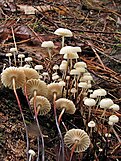User:Allard
Hello and a warm welcome to all my fellow Wikipedians. How nice of you to drop in to see who I am!
Morning>
Wikipedia & me:[edit]
How I discovered Wikipedia, I do not remember. But from being a reader I slowly became a contributor. Although I don't work that much on Wikipedia I do see myself as a Wikipedian. I don't go searching on Wikipedia what I can edit next, I edit what I find and want to do. This means I add and mainly improve a lot of small things and only rarely I make large edits.
My work:[edit]
Articles I've started on Wikipedia:
- Fort Knox Bullion Depository
- Animals are Beautiful People
- Template:David Attenborough Television Series
- Template:Malta Islands
Images I made for Wikipedia:
 Dutch lower house as from 2006
Dutch lower house as from 2006 New image of the Netherlands Air Force Roundel
New image of the Netherlands Air Force RoundelMap on membership of the League of Nations
United Nations membership map
 Improved image of the British Helgoland flag
Improved image of the British Helgoland flag New image showing the current flag of Hel(i)goland
New image showing the current flag of Hel(i)goland
Article guide:[edit]
A list of articles worth looking at, if one can find them:
- Antidisestablishmentarianism
- Ball's Pyramid
- British Isles (terminology)
- Eadweard Muybridge
- Gunpowder Plot
- Horace de Vere Cole
- Humphrey (cat)
- Islomania
- List of countries by date of nationhood
- List of flags
- List of people who died on their birthdays
- List of regnal numerals of future British monarchs
- List of unusual deaths
- Northwest Angle
- Quadripoint
- Racetrack Playa
- Rule of tincture
- San Gimignano
- Transcontinental country
- Undivided India & Partition of India
- Voyager Golden Record
- Web colors
- Winchester Mystery House
And there's always the Random article
And to all citizens of the European Union, please read this: Oneseat.eu
News[edit]
- In the Indian general election, the National Democratic Alliance led by Prime Minister Narendra Modi (pictured) is re-elected with a reduced majority.
- The Boeing Starliner spacecraft conducts its first crewed flight, carrying two astronauts to the International Space Station.
- The CNSA Chang'e 6 completes sampling and takeoff from the far side of the Moon.
- Claudia Sheinbaum is elected as the president of Mexico.
Selected anniversaries[edit]
June 10: Dragon Boat Festival in China and Taiwan (2024)
- 1624 – Thirty Years' War: France and the Dutch Republic concluded the Treaty of Compiègne, a mutual defence alliance.
- 1786 – Ten days after being formed by an earthquake, a landslide dam on the Dadu River in China was destroyed by an aftershock, causing a flood that killed an estimated 100,000 people.
- 1861 – American Civil War: The Confederate Army only suffered eight casualties in its victory at the Battle of Big Bethel in York County, Virginia.
- 1957 – Led by John Diefenbaker (pictured), the Progressive Conservative Party won a plurality of House of Commons seats in the Canadian federal election.
- 1987 – Mass protests demanding direct presidential elections broke out across South Korea.
- Isabella Andreini (d. 1604)
- Gustave Courbet (b. 1819)
- Ninian Comper (b. 1864)
- Alexandra Stan (b. 1989)
Did you know...[edit]

- ... that depictions of Tobias and the Angel (example pictured), unusually for a religious subject, typically show Tobias's dog?
- ... that Australian gamer Zer0 led his team to an Apex Legends Global Series championship with a substitution teammate to whom he had never spoken before?
- ... that Louisa May Alcott wrote A Modern Mephistopheles as part of an anonymous series in which readers were meant to guess the author?
- ... that the first model of cosmic inflation was formulated by a Soviet physicist but initially remained unknown outside the Soviet Union?
- ... that the Beep the Meep puppet created for "The Star Beast" took six people to operate?
- ... that football player Levi Drake Rodriguez, considered small for his position, went on an "eat-as-much-as-humanly-possible diet" to be noticed by NFL teams?
- ... that Macklemore's song "Hind's Hall" refers to Hind Rajab, a six-year-old girl who was killed in the Gaza Strip in January 2024?
- ... that starting at age 16, future Woolworths CEO Brad Banducci was named top sewing machine salesperson three years in a row?
- ... that the ancient Greek game polis is one of the world's oldest strategy games?
Today's featured article[edit]
Marasmius rotula, the pinwheel mushroom, is a fungus in the family Marasmiaceae. Widespread in the Northern Hemisphere, it was first described scientifically in 1772 by Giovanni Antonio Scopoli. The mushrooms are characterized by thin whitish caps up to 2.0 cm (0.8 in) wide that are sunken in the center and pleated with scalloped margins. The wiry black hollow stalks measure up to 8.0 cm (3.1 in) long by 1.5 mm (0.06 in) thick. On the underside of the caps are widely spaced white gills, attached to a collar encircling the stalk. The mushrooms grow in groups or clusters on decaying wood such as moss-covered logs and stumps. Spore release is dependent upon sufficient moisture. Dried mushrooms may revive after rehydrating and release spores for up to three weeks, much longer than most gilled mushrooms. Although the mushrooms are not generally considered edible, they produce a unique peroxidase enzyme that is attracting research interest for use in bioengineering applications. (Full article...)










